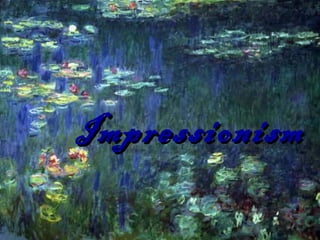
Impressionism
- 2. • Impressionism was a 19th century art movement that began as a loose association of Paris based artists, who began exhibiting their art publicly in the 1860’s. The name of the movement is derived from the title of a Claude Monet painting, called Impression, Sunrise
- 4. Impressionist artists felt the new technology of Photography was ruining the art of painting. They felt the need to create a new style of painting in which accurate rendering of the subject was not the main focus.
- 5. The Impressionists changed the approach to painting, by recreating the sensation in the eye that views the subject, rather than recreating the subject.
- 6. The public, at first hated the paintings, then gradually came to believe that the Impressionists had captured a fresh and original vision. The art critics of that time, continued to disapprove calling the paintings unfinished sketches.
- 7. Characteristics of Impressionist painting include: • Visible brushstrokes • Light Colors • Emphasis on Light and the changing qualities of it • Ordinary Subject Matter • Unusual Visual Angles • Open Compositions
- 9. Light Colors
- 11. The Changing Qualities of Light Haystack - Morning Haystack - Mist
- 15. Today the Impressionist style is very much alive and a very successful technique of painting. Though many artists have painted in the Impressionist style, the following artists were the innovators and masters of their style:
- 16. Masters of Impressionism • Claude Monet – Lilly ponds & Gardens • Auguste Renoir – People Outdoors • Edgar Degas – Dancers and Theater • Camille Pissarro – Cities and Streets • Alfred Sisley – Rivers and Landscapes
- 17. Paintings by Claude Monet Self Portrait
- 18. Artists Garden at Giverny - 1886
- 19. Haystack – Sunset -
- 20. Water lilies – The Clouds - 1903
- 21. Water lilies – Green Reflection - 1906
- 22. Paintings by Auguste Renoir
- 23. Gypsy Girl - 1879
- 24. The Boating Party - 1979
- 25. Monet painting in his Garden - 1873
- 26. The Swing 1876
- 27. Paintings By Edgar Degas
- 28. Miss la la at the circus Fernando
- 29. Horses Before the Stands - 1876
- 30. Cabaret - 1877
- 31. The Rehearsal -
- 32. Paintings by Camille Pissaro Self Portrait
- 33. The Orchard - 1872
- 34. Jallais Hills - 1876
- 35. Path Through the Woods - 1876
- 36. Boulavarde Montmarte – Rainy Afternoon - 1897
- 37. Boulavarde Montmarte – Night - 1897
- 38. Paintings By Alfred Sisley
- 39. Bridge At Villanueve - 1872
- 40. Banks of the Siene - 1873
- 41. Flood at Port Marly - 1876
- 42. Station at Serves - 1879
- 43. Church at Moret - 1894
- 44. Painting techniques developed and used by the Impressionists:
- 45. Short, thick strokes of paint are used to quickly capture the essence of the subject, rather than its details.
- 47. Colors are applied side-by-side with as little mixing as possible, creating a vibrant surface. The optical mixing of colors occurs in the eye of the viewer.
- 49. The play of natural light is emphasized. Close attention is paid to the reflection of colors from object to object.
- 51. Grays and dark tones are produced by mixing complimentary colors. In pure Impressionism the use of black paint is avoided.
- 53. In paintings made en plein air (outdoors), shadows are boldly painted with the blue of the sky as it is reflected onto surfaces, giving a sense of freshness and openness that was not captured in painting previously. (Blue shadows on snow inspired the technique.)
- 55. Impressionism became the birth of Modern Art. All of the major art movements which would follow, including Post Impressionism, Fauvism, Cubism, Surrealism, Abstract Expressionism and Pop Art owe their beginnings to Impressionism.
- 56. Advanced Art – Impressionism • Lesson Objectives – Students will have a general understanding of the theory and characteristics of the Impressionist style of art and the major artists of the style. Students will be able to analyze light more objectively and learn to paint using the techniques of the impressionist style. • Activities • 1 Students will be shown power point on Impressionism. Create a list of artists, characteristics and techniques of the Impressionist style • 2 Students will find examples of Impressionist style of painting from the internet at (ARTCHIVE). They will print 1 example of the artist of their choice and attempt to accurately reproduce the colors and brush strokes of the painting. Size will be 6x8. • 3 Students will produce an original painting executed in the Impressionist style. Size will be 11x14. • 4 Students will be given a test on characteristics, techniques, and artist work identification. • Assessment –Will be graded according the response to instruction, degree and quality of completion, craftsmanship, originality and appropriate classroom behavior. • Materials - poster board, tempera paint, acrylic paint • Standards • 1-KNOWLEDGE - STUDENTS KNOW AND APPLY VISUAL ARTS MEDIA, TECHNIQUES AND PROCESSES. • 2-APPLICATION - STUDENTS USE KNOWLEDGE OF VISUAL CHARACTERISTICS, PURPOSES AND FUNCTIONS. • "3-CONTENT - STUDENTS CHOOSE, APPLY AND EVALUATE A RANGE OF SUBJECT MATTER, SYMBOLS AND IDEAS. • "4-CONTEXT - STUDENTS UNDERSTAND THE VISUAL ARTS IN RELATION TO HISTORY AND CULTURE. • "5-INTERPRETATION - STUDENTS ANALYZE AND ASSESS CHARACTERISTICS, MERITS AND MEANINGS IN THEIR OWN ARTWORK AND THE WORK OF OTHERS.
- 57. Haystack – Sunset -
- 59. Cabaret - 1877